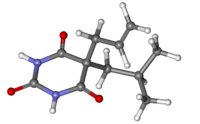Butalbital
 |
|
 |
|
| Clinical data | |
|---|---|
| AHFS/Drugs.com | Micromedex Detailed Consumer Information |
| MedlinePlus | a601009 |
| Pregnancy category |
|
| Routes of administration |
oral |
| ATC code |
|
| Legal status | |
| Legal status |
|
| Pharmacokinetic data | |
| Bioavailability | 20-45% |
| Metabolism | hepatic mainly CYP3A4 |
| Biological half-life | 35 hours |
| Excretion | renal |
| Identifiers | |
|
|
| CAS Number | |
| PubChem CID | |
| IUPHAR/BPS | |
| DrugBank | |
| ChemSpider | |
| UNII | |
| KEGG | |
| ChEBI | |
| ChEMBL | |
| ECHA InfoCard | 100.000.926 |
| Chemical and physical data | |
| Formula | C11H16N2O3 |
| Molar mass | 224.256 |
| 3D model (Jmol) | |
|
|
|
|
Butalbital is a barbiturate with an intermediate duration of action. Butalbital is often combined with other medications, such as acetaminophen (paracetamol) or aspirin, and is commonly prescribed for the treatment of pain and headache. The various formulations combined with codeine are FDA-approved for the treatment of tension headaches. Butalbital has the same chemical formula as talbutal but a different structure—one that presents as 5-allyl-5-isobutylbarbituric acid.
Combinations include:
Butalbital is not suggested as a first-line treatment for headache because it impairs alertness, brings risk of dependence and addiction, and increases the risk that episodic headaches will become chronic. When other treatments fail or are unavailable, butalbital may be appropriate for treating headache if the patient can be monitored to prevent the development of chronic headache.
There are specific treatments which are appropriate for targeting migraines and headaches which are preferable to butalbital when available as an option. It is a least preferable option to be used if other available treatments fail.
Side effects for any psychoactive drug are difficult to predict, though butalbital is usually well tolerated. Commonly reported side effects for butalbital, which tend to subside with continued use, include:
Rare side-effects include Stevens–Johnson syndrome, an adverse reaction to barbiturates, and anaphylaxis.
The risk and severity of all side effects is greatly increased when butalbital (or butalbital-based medications, such as Fioricet) are combined with other sedatives (ex. ethanol, opiates, benzodiazepines, antihistamines), and other side effects, which are not typically associated with butalbital, may occur. Inhibitors of the hepatic enzyme CYP3A4 may also increase the risk, severity, and duration of side effects, many drugs inhibit this enzyme as do some foods such as grapefruit and the blood orange. Taking butalbital-based medications with some other drugs may also increase the side effects of the other medication.
...
Wikipedia
